Unmasking Jack the Ripper: A Fresh Investigation into the Whitechapel Murders, Part 4
Posted on 06/02/2025 at The Curmudgeon’s Chronicle
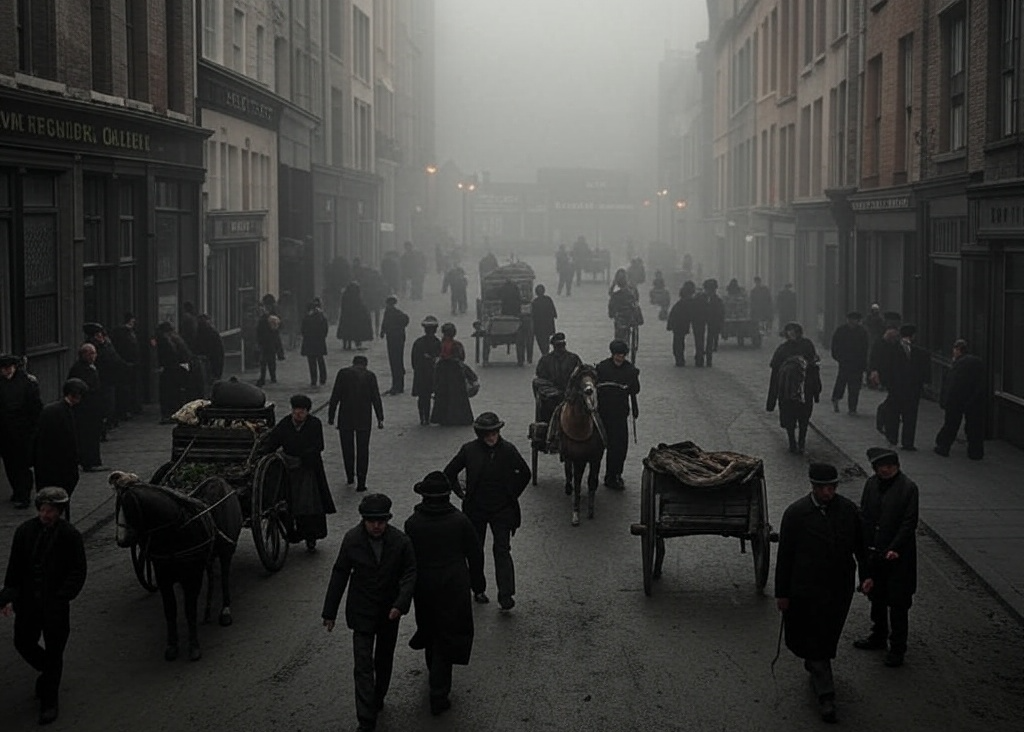
The Double Event – Stride, Eddowes, and Suspect Showdown
Three weeks after Annie Chapman’s mutilated body was discovered in the backyard of 29 Hanbury Street, the East End of London was on edge. The police had increased patrols, and whispers of a serial killer – “Leather Apron,” as the papers called him – spread through Whitechapel’s pubs and doss-houses. But the killer was undeterred. On the night of September 29, 1888, he struck not once, but twice, in a chilling escalation that would cement his legend as Jack the Ripper. Elizabeth Stride and Catherine Eddowes, two women struggling to survive in Whitechapel’s underbelly, became his next victims in what’s now known as the “double event.”
In this fourth part of our investigation, we’ll walk through the early hours of September 30, 1888, examining the murders of Stride and Eddowes – two killings in one night, just a half-mile apart. Using only 1888 evidence – police reports, inquest testimony, and contemporary accounts – I’ll evaluate our four suspects: Charles Cross, Joseph Barnett, Aaron Kosminski, and David Cohen. Cross and Kosminski have emerged as frontrunners after Chapman’s murder, but this double event will test their fit like never before. I’ll assign likelihoods for these murders and adjust their overall probabilities for the series, building toward my final reveal in a later part. Let’s step into the fog of Whitechapel and face the night the Ripper struck twice.
The Double Event: Elizabeth Stride and Catherine Eddowes
The night of September 29 began like any other in Whitechapel – cold, damp, and restless. Elizabeth Stride, a 45-year-old Swedish immigrant known as “Long Liz,” was seen soliciting clients near Berner Street, a narrow thoroughfare off Commercial Road. At 11:00 p.m., two laborers saw her with a man at the Bricklayer’s Arms pub, describing him as 5’5”, 28 years old, with a dark mustache, wearing a morning coat and billycock hat (inquest, October 5, 1888). By 12:35 a.m. on September 30, Israel Schwartz witnessed a disturbing scene outside Dutfield’s Yard, a small courtyard off Berner Street: a man arguing with a woman matching Stride’s description. The man, 30-ish, 5’5”, fair, with a small brown mustache, wearing a dark jacket and cap, threw her to the ground and shouted “Lipski!” – a slur likely aimed at Schwartz, a Jewish passerby, though some police speculated it was directed at a second man nearby holding a pipe (inquest). Schwartz fled, fearing for his safety.
At 1:00 a.m., Louis Diemschutz, a socialist club steward, drove his cart into Dutfield’s Yard and found Stride’s body near the gate. Her throat had been slashed once, left to right, with a deep cut severing her carotid artery – she was still warm, blood pooling beneath her (inquest). Unlike Nichols and Chapman, there were no abdominal mutilations. Dr. Frederick William Blackwell, who arrived at 1:16 a.m., estimated death at 12:46–12:56 a.m., suggesting Diemschutz’s arrival may have interrupted the killer (inquest). Inspector Edmund Reid noted the lack of mutilation but linked the throat cut to the previous murders (MEPO 3/140). Stride’s death, though less savage, bore the Ripper’s mark.
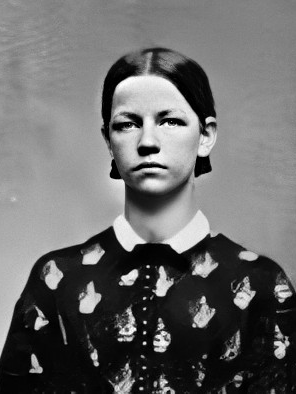
Elizabeth Stride
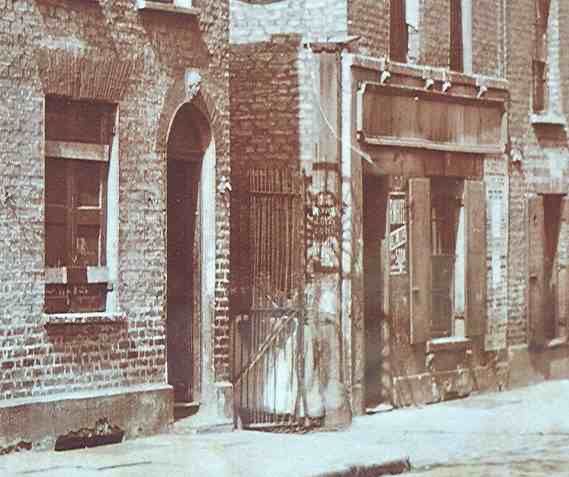
Berner Street, Dutfield’s Yard entrance: Elizabeth Stride’s body lay against the wall inside the gate.
Just 45 minutes later, at 1:45 a.m., Catherine Eddowes was found 0.5 miles away in Mitre Square, a small, enclosed plaza in Aldgate. Eddowes, 46, had been released from Bishopsgate Police Station at 1:00 a.m. after sobering up from a drunken arrest (inquest, October 4, 1888). She was last seen alive at 1:35 a.m. by Joseph Lawende, who spotted a woman matching her description with a man – 30-ish, 5’7”, fair mustache, “sailor-like” with a peaked cap and red neckerchief – standing at the entrance to Church Passage (inquest). PC Edward Watkins discovered her body at 1:45 a.m.: her throat was slashed to the spine, her face mutilated with cuts to her eyelids and nose, and her abdomen ripped open – intestines over her shoulder, uterus and left kidney removed (inquest). Dr. Frederick Gordon Brown, who arrived at 2:00 a.m., confirmed death at 1:35–1:43 a.m., noting “surgical skill” in the organ removal (inquest).
The double event didn’t end there. At 2:55 a.m., PC Alfred Long found a piece of Eddowes’ bloodied apron in Goulston Street, 0.3 miles from Mitre Square, beneath a graffito scrawled in chalk: “The Juwes are the men that will not be blamed for nothing” (MEPO 3/140). Inspector Thomas Arnold ordered it washed off by 5:00 a.m., fearing anti-Semitic riots. The graffito’s meaning – possibly “Jews,” possibly a Masonic reference – remains debated, but it fueled suspicion of a Jewish killer. Stride and Eddowes, killed within an hour, showed the Ripper’s audacity – one murder interrupted, the other unleashed.
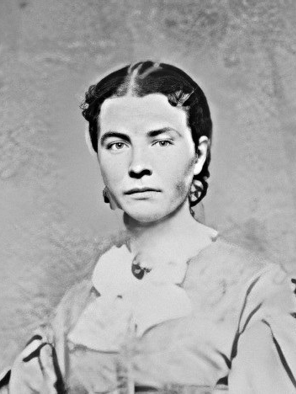
Catherine Eddowes
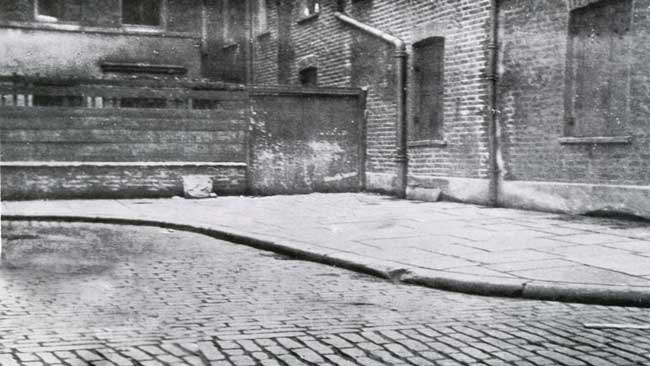
Catherine Eddowes’ murder site: South-east corner of Mitre Square
The Suspect Field: A Showdown in the Dark
The double event – two murders in one night, a half-mile apart – demands a killer with mobility, nerve, and a chilling efficiency. Let’s evaluate our four suspects – Charles Cross, Joseph Barnett, Aaron Kosminski, and David Cohen – using their proximity, opportunity, and fit with the evidence. At the end of each suspect’s analysis, I’ll assign a likelihood for these murders and an overall probability for the series, narrowing the field as we go.
- Charles Cross (aka Charles Lechmere): Cross, 39, lived at 22 Doveton Street, 1.2 miles from Berner Street and 1.5 miles from Mitre Square – not as close as he was to Nichols or Chapman, but still within Whitechapel’s web. More compelling is his mother’s 1888 residence at 147 Cable Street, where she lived with one of Cross’s daughters, just 0.4 miles from Berner Street and 0.5 miles from Mitre Square – placing him even deeper in the murder zone if he visited them that night, a plausible scenario given his East End roots and family ties. The timing of the double event – Stride at 1:00 a.m., Eddowes at 1:35 a.m. – falls outside Cross’s usual early commute to Pickfords (4:00–6:00 a.m.), but as a carman, he likely had Saturday night into Sunday morning off, his one night of freedom, meaning he could have been out in Whitechapel during those dark hours. The 0.5-mile distance between Berner and Mitre – a 10-minute walk – fits a man familiar with these streets, and Cross’s calm demeanor at Nichols’ scene suggests the nerve needed for such a brazen act. Schwartz’s description of Stride’s assailant – 30-ish, 5’5”, dark jacket – doesn’t perfectly match Cross, who was 39, though Lawende’s “sailor-like” man, 5’7” and 30-ish, is closer to his build. The progression from Stride’s interrupted kill (no mutilation) to Eddowes’ surgical precision aligns with Cross’s possible learning curve – Nichols was crude, Chapman more precise, and Eddowes a step further, though his lack of a flesh-cutting trade raises questions. Cross’s undeniable presence at Nichols’ scene keeps him in the spotlight – could he have been roaming Whitechapel that night, striking twice? I assign Cross a 50–60% likelihood for the double event, maintaining his 75–80% for Nichols and 55–60% for Chapman, with an overall probability of 45–50% for the series – he’s holding strong.
- Joseph Barnett: Barnett, 30, lived on Dorset Street, 1 mile from Berner Street and 0.8 miles from Mitre Square – closer than Cross and well within the murder zone. As a fish porter, he was used to late nights and early mornings, making his presence in the area at 1:00 a.m. plausible, especially on a Saturday night when he might have been drinking or working late at Billingsgate. But Barnett has no known connection to Stride or Eddowes – his motive in the Ripper case is tied to Mary Jane Kelly, driven by jealousy over her prostitution, which only emerges with her murder in November (inquest, November 12, 1888). His fishmonger skills align with Eddowes’ surgical mutilations – Dr. Brown noted “knowledge of anatomy” – but they clash with Stride’s simpler throat cut and the crude start of Nichols’ murder, suggesting a progression that doesn’t fit a personal grudge against Kelly. The police cleared Barnett after Kelly’s murder, finding no broader link to the series (MEPO 3/140, November 10, 1888). Schwartz’s and Lawende’s descriptions – 30-ish, 5’5” to 5’7” – match Barnett’s age and build, but there’s no direct evidence placing him at either scene. Proximity keeps him in the frame, but the lack of motive for these victims weakens his case. I give Barnett a 25–30% likelihood for the double event, maintaining his 30–35% for Chapman, with an overall probability of 25–30% for the series – he remains on the back burner.
- Aaron Kosminski: Kosminski, 23, lived in Sion Square, 0.6 miles from Berner Street and 0.7 miles from Mitre Square – placing him right in the murder zone, though Cross’s mother, living on Cable Street with his daughter, was even closer at just 0.4 miles from Berner Street and 0.5 miles from Mitre Square. As an unemployed barber known to wander the streets (1891 asylum notes), the 1:00–1:45 a.m. timeline fits his nocturnal patterns – Eddowes’ murder at 1:35 a.m. aligns with his likely habits, and Berner Street was on his doorstep. Schwartz’s description of Stride’s assailant – 30-ish, 5’5”, fair, with a small brown mustache – matches Kosminski’s height and possibly his “Jewish” appearance, especially given the “Lipski” slur, which targeted a Jewish passerby. Lawende’s “sailor-like” man, 5’7” and 30-ish, is less of a fit – Kosminski was younger and shorter – but the Goulston Street graffito, “The Juwes are the men…,” fueled police suspicion of a Jewish killer, a theory later tied to Kosminski by Chief Inspector Donald Swanson (1910). Kosminski’s alleged madness – “homicidal tendencies,” per Sir Melville Macnaghten (1894) – fits the escalation from Stride’s interrupted kill to Eddowes’ savagery, and his lack of a flesh-cutting trade aligns with the series’ progression, from Nichols’ crude cuts to Eddowes’ precision. But there’s no 1888 record placing him at either scene (MEPO 3/140), and his suspect status is hindsight. Kosminski’s proximity and the anti-Semitic clues make him a strong contender for this night. I give Kosminski a 60–65% likelihood for the double event, maintaining his 55–60% for Chapman, with an overall probability of 40–45% for the series—he’s closing the gap on Cross.
- David Cohen: Cohen, 23, was admitted to Colney Hatch Asylum in December 1888, with a possible address at Mile End Workhouse, 1–1.5 miles from both crime scenes – a less precise location than Cross or Kosminski. Some historians link him to “Nathan Kaminsky,” a syphilitic Jew possibly living at Black Lion Yard, 0.5 miles from Berner Street, but there’s no 1888 record to confirm this (Fido, 1987). The 1:00–1:45 a.m. timeline could fit a vagrant wandering the streets, and Cohen’s “violent, noisy” behavior in the asylum aligns with the savagery of Eddowes’ murder. Schwartz’s “Lipski” man and the Goulston graffito might point to a Jewish suspect like Cohen, but his height (unknown) and age don’t perfectly match the descriptions, and his lack of a flesh-cutting trade clashes with Eddowes’ surgical precision. Cohen’s profile largely echoes Kosminski’s, and his later timeline – post-Kelly – weakens his case. There’s no evidence placing him at either scene, making him a long shot. I assign Cohen a 30–35% likelihood for the double event, maintaining his 30–35% for Chapman, with an overall probability of 25–30% for the series – he’s still on the back burner.
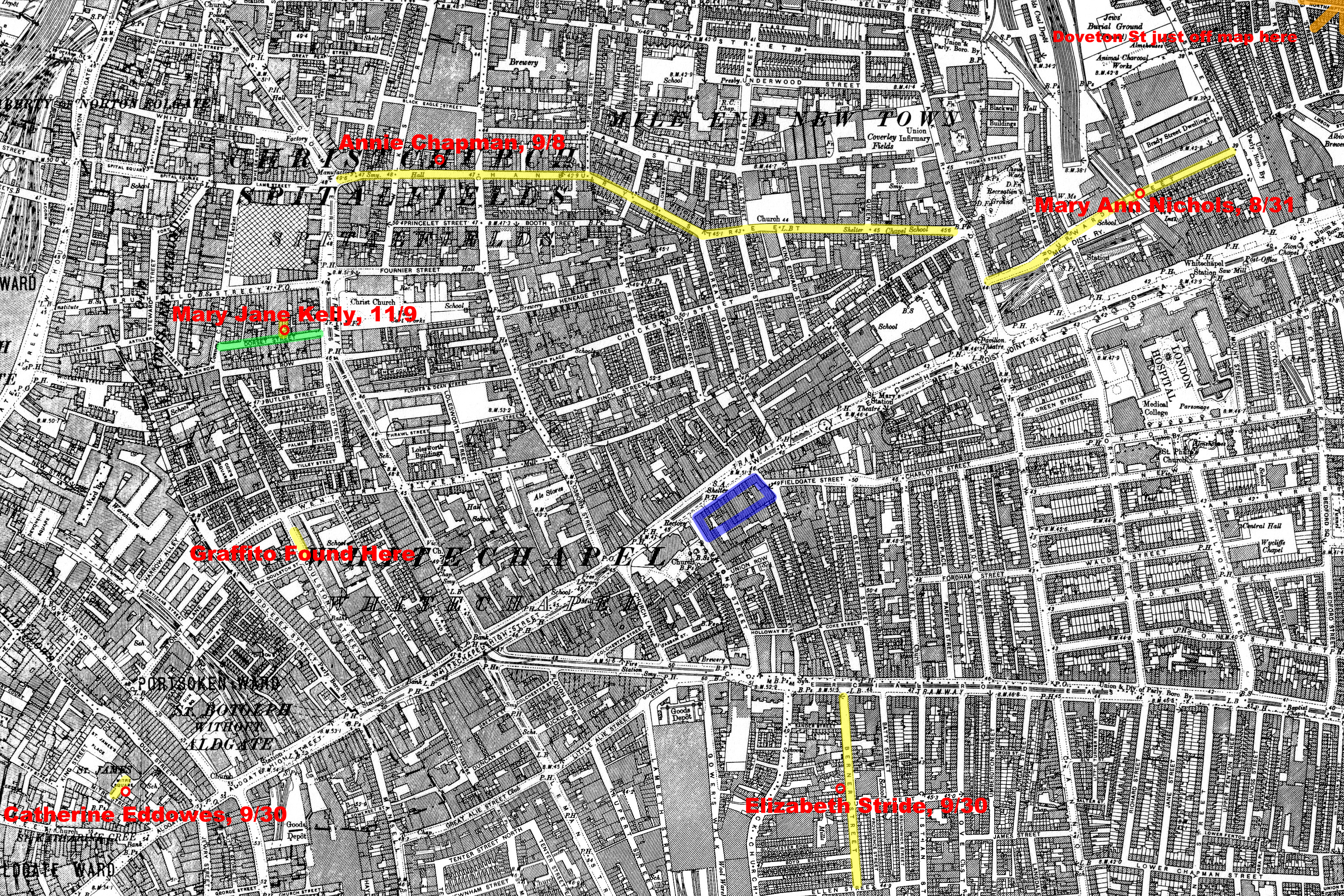
Whitechapel Map: Highlights Berner Street (Stride’s body in Dutfield’s Yard), Mitre Square (Eddowes’ body), and Goulston Street (Graffito site) among other marked locations.
A Night of Terror
The double event was a turning point in the Whitechapel murders. Stride’s interrupted killing and Eddowes’ gruesome mutilation, just 45 minutes and a half-mile apart, showed a killer with audacity and skill. The Goulston Street graffito added a layer of mystery, pointing to a possible Jewish suspect – or a deliberate misdirection. The Ripper was no longer a whisper; he was a scream in the night, and Whitechapel would never be the same.
Cross and Kosminski remain neck-and-neck – Kosminski’s proximity and the anti-Semitic clues give him a slight edge for this night, but Cross’s presence at Nichols’ scene keeps him in the lead overall. Barnett and Cohen lag behind, their proximity overshadowed by a lack of motive or direct evidence. The final canonical murder – Mary Jane Kelly’s – will push our suspects to their limits, and one man will rise above the rest.
Does Kosminski’s Jewish connection make him the Ripper, or does Cross’s steady presence hold the key? Share your thoughts in the comments below, and join me next time as we face the final murder: Mary Jane Kelly’s gruesome end – and a suspect takes center stage.